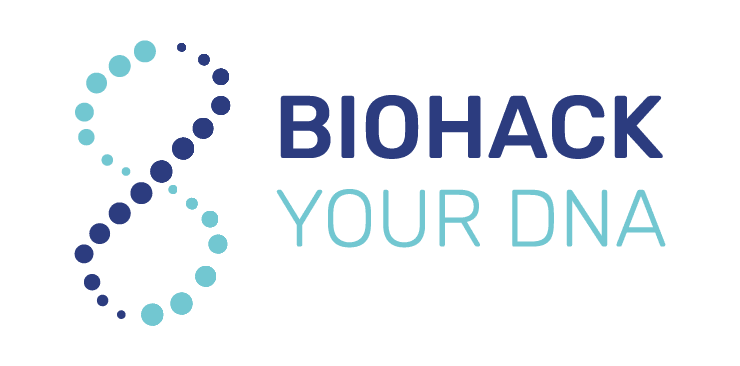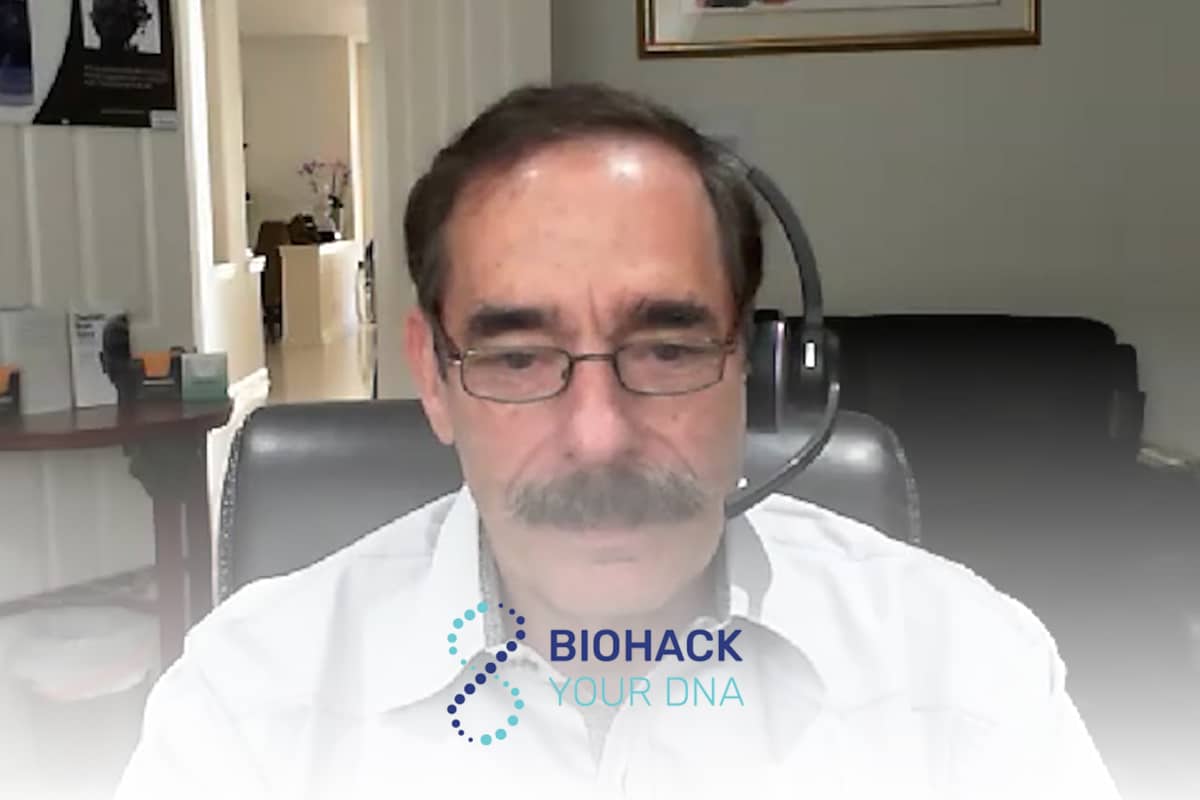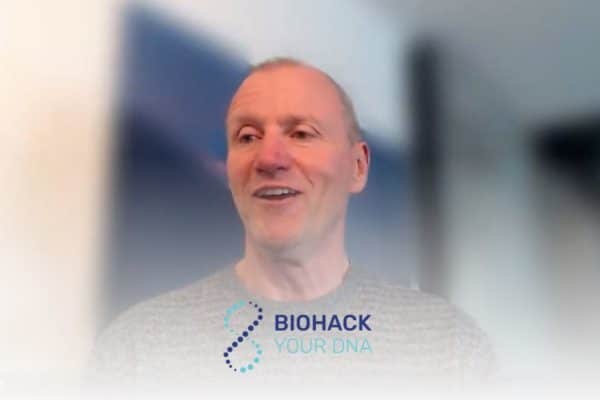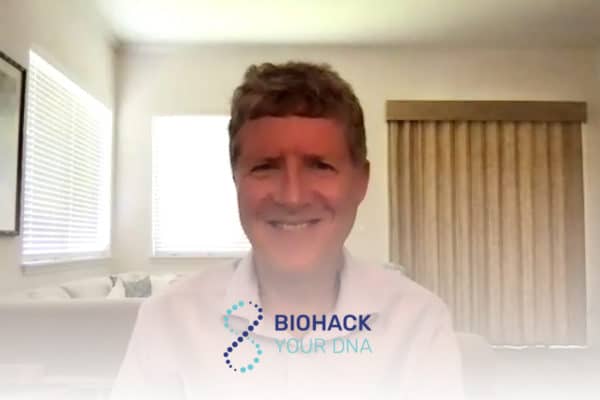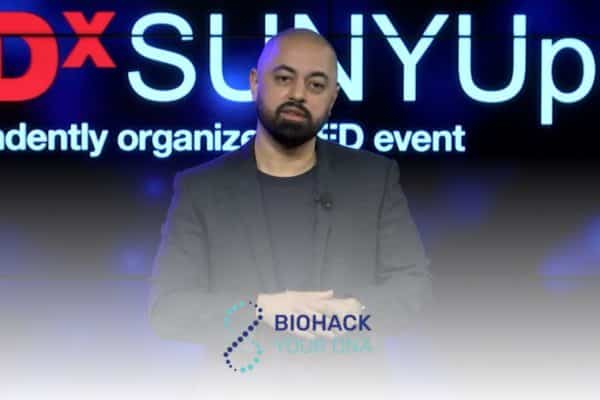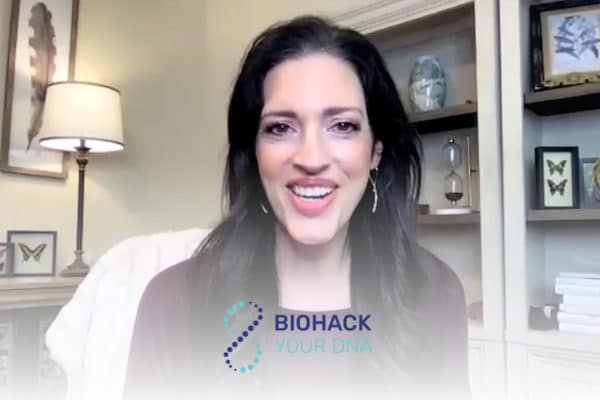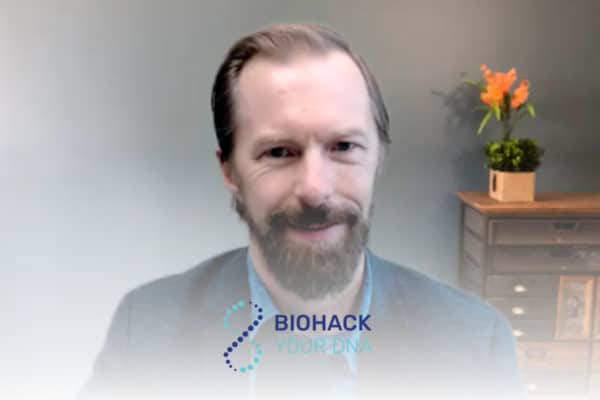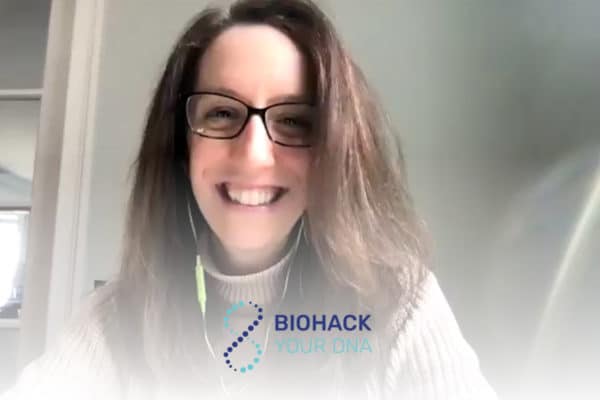Join the discussion below

Kashif Khan is the Chief Executive Officer and Founder of The DNA Company, where personalized medicine is being pioneered through unique insights into the human genome. With the largest study of its kind globally, The DNA Company has developed a functional approach to genomic interpretation overlaying environment, nutrition, and lifestyle... Read More

Dr. Mark L. Gordon continued his medical education in Clinical Orthopedics (1990), Cosmetic Dermatology (1993), and Sports Medicine (1995) prior to pausing in 2007 to write his first book on Interventional Endocrinology a term which he coined in 2003 to represent his approach to Anti-Aging Medicine. His book, The Clinical... Read More
- What causes inflammation/neuroinflammation in the brain? Civilians & Military
- What is the concept of Biological Resiliency
- How does neuroinflammation/inflammation cause neuropsychiatric conditions
- How do you diagnose these conditions
- What is the treatment that you have developed and are using in the Military cases of PTSD
Kashif Khan
All right, guys, we’re talking to Dr. Mark Gordon, and we’re gonna be diving into neural inflammation, but I got a pretty good sense it’s not gonna end there, because if you look this guy up and see what he’s been working on, it’s a little bit of everything, solving problems from celebrities, to athletes, to executives, and you name it, he’s been able to pinpoint root cause for a lot of this stuff. I had the pleasure and honor of diving into a platform that was built based on the insights, the many years of work that Dr. Gordon has been doing and putting it together so that practitioners can now extend their brilliance, call it, the work that Elon Musk is doing of implanting a neural chip into your brain and uploading a matrix style, what you could potentially know, you essentially are bringing that to the medical community. So, first of all, thanks for joining us. It’s really an honor to have you here.
Mark L. Gordon, M.D.
Ah, it’s a pleasure. It’s always a great opportunity to share the experience of 41 years in medicine and 27 years in the area of neuroendocrinology.
Kashif Khan
For sure, and yeah, you blew my mind just looking at how you made such complex stuff so easy, but I know that took a lot of work on your end, ’cause it was literally downloading from your brain what needed to be uploaded to everybody else’s, right?
Mark L. Gordon, M.D.
Well, I look, yeah, I look at myself as a conduit. I spend a lot of time reading articles. I go through 15 to 20 plus articles a week looking for sources of science that can help me to better what I’m doing on a daily basis. I presently work exclusively with the military and these guys in the United States are having significant issues that you’ve seen in Canada relative to PTSD, what they call PTSD, but it’s really that neuroinflammation, which is creating the problem. And this is one of the reasons why I have a hard time buying in fully to the complex that they refer to as PTSD, posttraumatic stress disorder or posttraumatic stress. And that’s because only eight years ago, we found out where we, the research brilliance of people doing bench work, found a chemical in the brain called fractalkine, which keeps the inflammation in the brain at bay, quiet, but under certain situations like stress where cortisol rises.
So you can be in a home setting where it’s a lot of stress, you can be in a job where there’s a lot of stress, you can be out in the field of battle with military, and a lot of stress, cortisol level goes up, and it shuts off this thing called fractalkine allowing the cells of the brain to start dumping cytokines, wait a second, cytokines. Isn’t that also associated with cytokines storm that creates the situation of lungs that kills you? In the brain, the same thing happens. And the cells responsible for generating these chemicals called cytokines, which are either pro-inflammatory or anti-inflammatory, ones that hurt or protect you, and the others that clean up the mess, the anti-inflammatory. Once you ignite the cells or activate the cells called microglia, they start dumping these cytokines in the brain. And over the course of time, it will lead to disruption of the biochemistry of the brain. And what we now know from that brilliance out there in the research world is that, if you’ve had a head trauma, whether or not it’s a physical or non-physical, meaning, traumatic or non-traumatic, whether or not it was surgery, whether or not you broke your leg, as opposed to being in an auto accident where you lose consciousness, or motorcycle accident where you lose consciousness, or being exposed to repetitive gunfire in our 50 caliber gunners that we see, or exposed to an IED or artillery fire, whatever kind of blast wave, what happens is the brain generates this process through cortisol of inflammation in the brain, which we found 17 years down the road.
So depending upon the length of time, it’ll interfere with biochemistry. So one of these articles that was really amazing was the fact that this inflammatory environment can cause to disruption of enzyme pathways. So the most important two enzymes are the ones that take the amino acid tryptophan that we have in turkey. Thanksgiving in the United States, we eat turkey, and what do we feel after we finish eating turkey? We feel tired. It’s not the eggnog or the scotch or the 15 beers that you usually have, but it’s the fact that tryptophan. So in order for tryptophan to be metabolized through something called tryptophan hydroxylase, it converts it from tryptophan to serotonin. Serotonin is the anti-depression medication or the anti-antidepressant neurotransmitter. And then it is converted through with another decarboxylation enzyme to melatonin. And if you block that process from tryptophan to serotonin to melatonin, you end up with three classical symptoms. By not having serotonin, depression, by not having melatonin, insomnia, and the backup of tryptophan gives you fatigue. So what we see in all our traumatic and non-traumatic brain injury cases is the occurrence of depression, insomnia, and fatigue.
And if you fix the inflammation of the brain, the neuroinflammation, what happens is, you can regain the production of serotonin. And one of the issues is the bulk of the medications that are used in depression are serotonin uptake inhibitors. So it assumes what? It assumes you’ve got adequate amount of serotonin being produced. As I just shared, if you have neuroinflammation or inflammation in the brain, what’ll happen is it’ll interrupt this chemical pathway. Well, it turns out there are a whole bunch of pathways that are interrupted, making testosterone or estradiol in females is interrupted by this inflammation, which there’s a relationship between one of the types of cells in the brain called astrocytes, it’s a glial cell, astrocytes, which feed the area of the brain that regulates the pituitary’s production of what they call trophic hormones. So if you have inflammation, these cells cannot signal to the hypothalamus and the hypothalamus cannot signal to the pituitary relative to testosterone and estradiol. So what happens is you lose the production of those hormones.
So how we’ve been able to, we have a small pilot with nine, pilot program with nine veterans who have doubled their testosterone production just by addressing the neuroinflammation, and the same thing happens with growth hormone. And why is that? We need estradiol in our brain, males and females, to stimulate growth hormone production. So as I just shared, if inflammation disrupts the hypothalamic stimulation of luteinizing hormone and stimulating hormone to turn on estrogen, testosterone production in the gonads, male and female, what happens is you lose that estradiol that allows or helps as a signal, in and of itself, to increase growth hormone. The same thing with thyroid, increased cortisol in the brain under stress, and you shut down thyroid stimulating hormone from the pituitary. So just from this inflammatory process, you lose four major hormones. And that is why we see emotional psychiatric conditions develop. And if we look at the literature in terms of depression, there are 500,000 plus articles talking about thyroid as a deficiency or insufficiency being predisposed to developing depression, and there’s about 180,000 articles with testosterone.
So if you look at testosterone and thyroid, the thyroid has greater amount of articles supporting the fact of how, if you’re deficient in it, you’re going to have the high risk of depression. And I don’t believe that the majority of healthcare providers are looking intensely enough at thyroid because we find that thyroid, the thyroid gland in our neck produces T4, which is like a precursor, which is converted to T3, which is the active form, turns out that T3 keeps stem cells in the brain active. They call ’em OPCs. And if you don’t have adequate amount of T3, you’ll lose those stem cells, the OPCs, and they’ll convert to end stage cells, which don’t produce the growth factors and the repair factors like brain-derived neurotrophic factor, which is one of the main growth factors that help to repair and regenerate neurons in the brain. So that’s interrupted by this inflammatory process.
Kashif Khan
It sounds complicated, but you’ve actually taken something that has been made oversimplified and just answered it. Meaning that, we take these conditions and we silo them out as separate siloed problems. We oversimplify what’s going on, you got a thyroid problem, you got a PTSD problem, you got, and nobody’s asking why. And then all of a sudden, you’re treating each condition separately, and then all of a sudden, you have five problems instead of one. Whereas what sounds complicated is actually you simplifying it to here’s where we actually need to focus, right? Here’s the root of all these folks. And that’s no wonder why you’re doing this brilliant work with the military. So when you’re diving in, you’re laying out here what’s really going on. So what are you doing to resolve the issues then?
Mark L. Gordon, M.D.
Well, first thing we do is we do our millennium biomarker panel, which is 28 markers. And those 28 markers reflect the impact of inflammation on the ability of the hypothalamic pituitary access to generate the signals, to turn on hormone production. So what we do is we address the deficiencies at that moment, the deficiencies that we’re finding or insufficiencies. And the reason why make the distinction between deficiencies in insufficiencies, I mean, you can wait until the person is suicidal or when they’re below, they’re in the lowest level of the hormone, or you can find them in the lowest quartile, the lowest 25% of the range and start interdiction or treatment at that point to mitigate the possibility of them developing schizophrenia, anxiety, depression, panic attacks, and so forth.
So what we do is we will replenish to a optimal physiological level. What is that? Well, whatever the range is for laboratory, we go from the 50th percentile to the 75th percentile of that laboratory range. What traditionally happens is, if a range hypothetically is between 10 and 90 and you come in at 11, the common response by the healthcare provider is that you’re normal, you’re within the ballpark. But what happens is the patient complains of symptomatology that’s like below the lowest or non-existent. And the common response there is, oh, that’s because you’re depressed or that’s because you’re so forth and so on, and that’s really not the case. And it’s the analogy I use is, there are two people sitting in front of me, one has $100 in their pocket, the other one has a million dollars in their pocket. I can honestly say they both have money, but the question is which one do you wanna be?
Kashif Khan
Yeah.
Mark L. Gordon, M.D.
You want to be just a little or do you want to have that adequacy that gives us the cognitive ability, emotional stability, our physical agility? I mean, that’s what the goal is as we age. I’m going to be 70 and I’m functioning at a very, very high level because I had six head traumas and lost growth hormone, testosterone, thyroid, which put me on antidepressants back in the ’90s. And because I was an avid reader, I came across articles that showed me the research that had been done, it’s on the bench, which means that it hasn’t come into mainstream medicine. And a lot of the stuff that I do has not come into mainstream medicine. It’s being rejected or put on the back burner or people are just not looking at it. And that’s what generated or forced me, not forced me, it encouraged me to do, seven years ago, a journal club where every Sunday I release an article as you now know, if you got the one this Sunday-
Kashif Khan
Yeah.
Mark L. Gordon, M.D.
An article, which has some really major impact on the quality of what we can do for our patients and for ourselves. Half the people who are receiving it are patients. The other half of the are the clinicians that I interact with. So in treatment, we use the laboratory results to direct us in a treatment protocol. Now it’s taken me 41 years of medical understanding and exposure and 27 years of actually doing this to be able to apply the sciences. But as you said, it’s complex, convoluted, and overwhelming. So that’s what led me in 2015 when I launched my book on “TBI, A Clinical Approach to Diagnosis and Treatment.” When my colleagues who had taken the class came up and said, “This information is overwhelming.” I can’t take your class on Thursday, Friday, and Saturday.
And then Monday morning expect to start using it. And that’s what led me into writing the software over the past six years, the Millennium Office Assistant, which actually analyzes your blood, it looks at symptoms that you enter into the system, it looks at the medication that they’re on, and it looks at the supplements that they’re on, because certain medications, certain supplements will influence the output of laboratory, your results from any clinical laboratory. And that would lead to either over or undertreatment of the patient. But once you understand that a drug like Wellbutrin will increase production of growth hormone, which will increase the production of T3 and drop the production of T4, will increase prolactin, increased prolactin shuts off luteinizing hormone so you can’t make testosterone.
So there are certain medications that will give a false presentation of what’s really going on in the patient. So it incorporates that into the system and gives you a four-page report, which tells you how to, what the diagnoses are relative to the labs, relative to the medication, and then gives you suggestion on how to treat. So I have three daughters, two of ’em are docs, Erin and Allison, and Rochelle’s the smart one who stayed out of medicine and did business. And so Alison works with me, she’s a naturopathic doc who functions on a high level of endocrinology and neuroendocrinology, and it took me 18 months to acclimate her to being proficient at what I’m doing. The software does it in 15 minutes. So you can take any healthcare provider and give them access to our proprietary laboratory work and the program, and they can enter it in there with all the parameters. And what happens is they get a four-page report that directs them in options, or gives them recommendations on what they can do to resolve the issues.
Kashif Khan
Right, so like you said, when we talk about the work, like the first example you laid out, which started at PTSD and took us down as rabbit hole of many different things, the challenge then is the clinician says, “Well, this is not part of my toolkit. I don’t have the training, I don’t look at the condition from that perspective, I’m not even supposed to look at it from that perspective, ’cause the solutions that I can provide you don’t deal with it from that perspective,” right?
Mark L. Gordon, M.D.
Right.
Kashif Khan
Meaning, even at the supplement level and understanding co-factors and how the body biochemistry is interrupted. So all of a sudden, you have the reality of, well, this sounds amazing, but my doctors didn’t know how to do it, so great sign up for the the software, get them going. But meanwhile, you are doing it with the military, right? So the same people making the decisions on what’s safe and should be available are also saying, “This is actually what we need ’cause what’s safe and available doesn’t work,” right?
Mark L. Gordon, M.D.
Right, well, when you look at what we’re doing, about 80% of our treatment protocol is based upon nutraceuticals, people call them supplements, so these are nutraceuticals. And for the past, since 2004, what we’ve been doing is working on these combinations of nutraceuticals from quercetin, to DHA, to gamma-tocopherol, acetylcysteine, these have incredible amount of inflammation relative to how they function at the molecular level, at the cellular level to improve upon the communication that is disrupted, as I shared, the biochemical disruption of the signaling mechanisms. So, also one of the components has in it, things like PQQ and CoQ10, which upregulate the ability of the cell through the mitochondrion, to make ATP, the energy that runs the brain. So it’s not just about reducing the inflammation, it’s about feeding the cells with the nutrients to optimize energy production, so you go from fogginess to clarity.
Kashif Khan
This, in a nutshell, what you refer to as biological resiliency?
Mark L. Gordon, M.D.
Yes, well, biological resiliency is what came to mind when I would see the military, the veterans who lost their position in the military because of medical conditions derived from being exposed to blast wave. So I had teams where they were all exposed to blast waves. And why is it that only two out of the six developed symptoms? What is the issue? So I started looking at this concept of biological resiliency where things that we do to our body, for our body protect us. As I explained to the military, it’s like putting layers of Kevlar. Kevlar is that bulletproof stuff that they wear in their vests. And so through biological resiliency, doing the right things. What are the right things? Low alcohol intake because alcohol sheds the Kevlar plates, good hydration, meditation to drop cortisol level, good nutrition, and exercise, because exercise has a multitude of benefits that we’re now starting to appreciate, high impact interval training increases testosterone level, high impact aerobics increases growth hormone.
It also both increases the neurotrophic, the brain-derived neurotrophic factor, which is a key element for repair of the brain and it’s growth factors. So these are things that can improve the biological resiliency, having good levels of Omega-3s in the system, tocopherol, vitamin E, gamma-tocopherol, very important. Colleague of mine, Dr. Michael Lewis, Colonel Michael Lewis, wrote a book called “When Brains Collide.” It was his thesis out of the military on how important Omega-3s are in protecting the brain and also dropping inflammation throughout the body. And it’s because of Michael that we ended up putting DHA into one of our products, it’s one of the capsinoids or Omega-3s. And he was trying to get the military to modify their nutrition. So it give the active servicemen a little bit more edge or more biological resiliency, so when they were out in the field of battle, that they weren’t as susceptible to succumb to traumas from the battlefield so.
Kashif Khan
So everything I’m hearing you say is, you’re taking science, like you said you’re reading and you’re constantly downloading and getting up to date, and you’re creating precision. Meaning, here’s exactly what this person needs regardless of what the limited toolkit as you’ll find other tools. So does this also apply in prevention? ‘Cause we’re talking about people in problem states and you’re understanding the problem at the root cause level, even beyond, because you’re looking at co-factors and where it extends that spider web that happens to grow when you take something. Does this apply to somebody who just wants to be optimal, that doesn’t have a particular problem to solve?
Mark L. Gordon, M.D.
Yes, that’s a great question. The way that it became resounding for us was the fact that we had patients who were on our protocol for a year, a year and a half, and resolve their prior trauma. And then what happens? They get into another auto accident and they freak out initially, oh, it’s gonna take me another year and a half to get better. Well, what happens in two to six weeks is they improve much more rapidly. And that’s because they had the biological resiliency restored and augmented. We have people who are utilizing our product, the key one being Brain Rescue 3. They’re using it without a history traumatic brain or anything whatsoever. They’re using it is, not only prophylactically, but because it helps to remove a lot of the cobwebs or the improved clarity in the brain and a lot of mental energy is generated.
So neutropic, that’s a way that you can call it, I try to stay out of that arena, but it’s being dragged into the neutropics with the brain smart products where people, some of my vets, after they recover, they’re saying that they’re now back in school. And if you saw the movie “Quiet Explosions,” there was Green Beret gentleman who was veteran, who was shot in the stomach while he was out in the field of battle, came home, recovered, but had a lot of difficulty cognitively with his brain functioning. He saw one of our programs on Joe Rogan with my patient and partner, Andrew Marr, ex-Green Beret, and he ended up coming on the program. And lo and behold, he ends up getting a dual masters, one from MIT and the other from Harvard concurrently.
Kashif Khan
Amazing.
Mark L. Gordon, M.D.
Yeah, and we’ve got two guys, one in Flagstaff, Arizona, the other in Charlotte, North Carolina, both special ops guys who graduated with a physician assistant degree. And one of them had graduated from Loma Linda here commented that he wouldn’t have been able to have achieved summa cum laude, student of the year award, most, what is it, voted in by the nurses at the hospital, the most capable physician assistant. He won all these awards, having gone from not able to function to being able to excel. And it’s the same thing with my partner, Andrew, who is on 13 medications, full blown alcohol and suicidal, where he ends up going to the Stanford Ignite Program, graduating from Pepperdine with an MBA. He starts a foundation called Warrior Angel Foundation with his brother, Adam. They write the book, which originally was “Tales from the Blast Factory,” that gets picked up by a producer, documentary producer, and made into the movie “Quiet Explosions,” which in 2021, won the Most Important Film of the Year Award, and this year was nominated for an Academy Award as a documentary.
The film’s about the results of the work that we’ve been doing for the past 18, 20 years, 27 years is when I started with the military in 2009, with NFL and so forth was back in 2022. So the film talks about how people, where they were, they got on protocol, and where they’re at now. So you see the progression, not only in military, there’s football players, there’s gymnasts, there’s surfers, there’s one gentleman with a heart attack, cardiovascular condition with an extensive surgery that left him cognitively and emotionally impaired. And within six to eight weeks of being on protocol, he had a significant recovery in those faculties. And now we have a couple of cases of Alzheimer’s, the oldest is 72, the younger is 66, female, 72-year-old male, who according to their custodians have gotten better. One gentleman out of Great Neck, New York, 70 years of age, came on board to our 100% nutraceutical program, and his wife monitors him. And within three months, he went from a sedentary, depressed state to being in the gym three days a week with a trainer.
And then we modified his protocol based upon some new information, and he’s nine months into his program. His wife starts stating that he’s getting his fine memory back where it’s about person, place, and thing. When you assess people with dementia, Alzheimer’s, you ask ’em, “Where are you? What’s his person’s name? What’s today’s date?” Who’s the president?” and so forth and so on or else to draw that clock. Salvador Dali clock is how it usually ends up, but 3:15 and so forth, the one with the melting clock from Salvador, yeah, that’s cool, cool picture. Anyway, so we have that. We have gal who flies in from Sweden who had 70% improvement in her Parkinson’s disease in three months, and so she flies in. I talked, go ahead.
Kashif Khan
There’s some mechanism there, like, is it neuro repair?
Mark L. Gordon, M.D.
Great question, great question. Neuroinflammation appears to affect the dopaminergic neurons that are located in the substance nigra, which is the primary area that dopamine is produced. Now, Parkinson’s is a conditional, motion condition that’s due to loss of dopamine. So there are things that we did to improve her production of dopamine and that’s dropping the inflammation, also making sure that her testosterone, estrogen levels were at the 75th to 100th percentile of the range, the reference range. And that’s because testosterone in and of itself is an incredible anti-inflammatory product. We talk about our hormones, our sex hormones, if you will, as sex hormones, reproductive hormones, and it turns out that they have a multitude of benefits on different systems in the body.
We call it pleiotropic. Now one of the benefits of testosterone is it directly drops the inflammatory, pro-inflammatory cytokines, which they label like interleukin-1, 1B, 6, and tumor necrosis factor alpha. On one side, it suppresses the pro-inflammation, and on the other side, it raises the anti-inflammation, interleukin 10. And at the same time, it stimulates the CD4 and CD8 cells. These are the innate immunity cells so it bolsters your immune system. And this is just testosterone. Well, it turns out estradiol does the same thing, and also shuts off a major inflammatory system in the brain. That’s why when a woman is going through her change of life, menopause, perimenopause, premenopause, postmenopause, you wanna make sure that her levels of hormones are ideal, ideal. And the range we use is 25 to 35 years of age. We want that range.
Kashif Khan
Sorry.
Mark L. Gordon, M.D.
Go ahead.
Kashif Khan
Just thinking, ’cause you’re you’re I mean, you’re making me think about a lot of stuff, my head is spinning. But right now there’s a huge wave of BHRT and hormone replacement therapy. It’s recommended to any woman that hits a certain age by any type of sort of antiaging or integrated type doctor. It sounds like to me, based on the depth of what you’re saying, the pathways actually look like that a lot of people are not getting what they actually need. I’m assuming this, right? I’m assuming that the intentions are right and there probably is the right protocol for them, but probably things are happening at a more generic level than they need to be. So is there damage being done there? What do you think?
Mark L. Gordon, M.D.
Well, is there damage being done there because they’re not on optimal medical care? Yes, and we know it because as I’ve shared with you, we’ve been able to reverse the process, we’ve been able to improve upon the process in Parkinson’s, multiple sclerosis, Alzheimer’s, dementia, all the labeled psychiatric illnesses. I mean, there’s a whole bunch of articles that have come out correlating each one or each grouping of these inflammatory, pro-inflammatory cytokines with every kind of psychiatric illness. So you’ll see the most common ones are the interleukin-1, 1 beta, six and tumor necrosis factor alpha that are associated with all the psychiatric conditions. I’ll send you the article. And there is a multitude of articles in the past decade have been coming out, talking about this, but they’re on the bench, they’re on the back burner, they have not come into mainstream medicine for obvious reasons.
I mean, if we change the narrative from it being a inflammatory precipitated process or processes and not an endstage neurotransmitter deficiency. Well, the inflammation causes the neurotransmitter deficiency. So why not start at the causation, the root causes you just stated? That’s the focus. You need to go and address the root cause so that you have all the benefits. Right now, everything we’re doing is masking the root cause or the symptomatology. And that’s why you get into such symptoms, side effects, because you’re putting on lots of medication. As I shared, my patient partner was on 13 medications and he was still having problems. I mean, one of the most common things that I’ll ask or one of the consistent things that I’ll ask our patients is, “Okay, I see you’re on three psychiatric medications, do you have depression?” And they say, “Yes.” And the reason why they say yes is because there are five hormones that when they’re deficient are associated with treatment-resistant depression or atypical depression.
One of the articles that came out in 2017, I believe it was, out of England, was talking about how, in a group of people had this treatment-resistant depression, that 61%, 61, 61% of them had growth hormone deficiency. And within one to two months of regenerating or bringing their levels of growth hormone to a higher level, they had resolution or improvement in their depression. And along with it, they had four additional benefits. They slept better, they had brighter minds, they had better interpersonal communication, and they were less emotionally volatile flying off the handle, which is very common thing that I see in our pretreated patients, both civilians and military. And the common comment that they make is that, “Geez, things that used to set me off, I just walk by them. They don’t bother me anymore.” And that’s their mental resiliency. It’s no longer a trigger, it’s now the system that triggers it is no longer working with that sensitivity, and we’ve seen this. When inflammation occurs in the brain, it generates something that we call free radicals, oxidative stress, reactive oxygen species, they’re all the same thing. And it turns out that these inflammatory radicals, reactive oxygen species, combines with another chemical called nitric oxide, which is very important for keeping blood vessels dilated, and it’s in and of itself a very important signaler for our cells, signaling mechanism.
So when they two join together, the ROS and the nitric oxide, it forms another chemical called peroxynitrite. Now peroxynitrite destroys enzyme systems, affects DNA, RNA, cell surface, disrupts the cell surface so that it cannot function, and the cell surface of every cell has receptors that recognizes enzymes, hormones, amino acids, everything. And if you disrupt that and there’s a disturbance in it, the signaling mechanism stops. And what happens is cells begin to die because the regulation of the flow of different ions, like sodium, potassium, chloride, into the cell, calcium, yeah, into the cell becomes nonfunctional and things just start dumping into the cell like calcium. And when calcium overloads the cell, they refer to it as excitotoxicity where it kills the cell. So calcium accumulates in the cell and kills the cell in something called apoptosis or programmed cell death, so you wanna stop that. And that’s where a medication like ketamine comes into play. Ketamine helps regulate the calcium influx through calmodulin and phospholyzation of the calcium of the calcium enzyme system to cause calcium to create the damage that it does in one set of cell, of neuroreceptors, the NMDA receptors. So it’s a very complex set of processes that are initiated by that singular trauma. And the problem is that, a lot of people forget that they had a car accident or had a slip and fall or whatever, and that’s because in a lot of these cases is something called retrospective or prospective amnesia.
I mean, I was struck by a car when I was 12, one of the six insults I had, I was struck by a car while I was riding my bike. And I forgot about it until I was sitting across from one of Lance Armstrong’s guys and he was telling about his car accident or his bicycle accident, and like a image in my brain, I saw myself being hit, and I said, “Darn.” So people don’t remember their accidents, but the lab tests disclose it. Many, many patients coming in, civilians coming in saying, “I’ve never had a head trauma. I’m here because I’ve just got depression.” And I say, “Aha, let’s go and investigate their background. Tell me what happened at birth. Was it forceps deliveries? Was it natural spontaneous?” “No, I was C-section, I was caught in the birth.” That’s number one. “Between the age of birth and five years of age, did you ever learn how to walk, or roller skate, or skateboard, or bicycle ride?” “Yeah, of course.” “Did you ever fall?” “Yeah, lots of times.” “How come you didn’t put that down on the papers? How about between the ages of five and 20 or 15 before getting a car? Any car accidents as you’re a passenger?” “Oh yeah, my pop got into an accident.
I was sitting in the back.” And these things you need to really investigate and you find out that they had all these traumas, but you’re looking at the lab results. And the lab results have very, very clear patterns of someone who’s had traumatic brain injury or a neuroinflammatory condition. Certain medications can do it, surgeries, prolonged surgeries. What happened to poor Robin Williams? He was in surgery for what, 13 1/2 hours to reset his heart. And what happened was he lost, because of cortisol, he lost testosterone and thyroid, and he had cortisol go up, which increased the amount of inflammation through this fractalkine deal. So he had all the medications and all the neuro pathways that he was responding were dependent upon to keep him his level of depression low was lost.
So when he committed suicide, they did a full spectrum of biologicals on him to find out if he was on anything that could have caused it, drugs. He was only on everything that he was prescribed. He wasn’t on anything else, no alcohol, nothing. And so surgery. So there’s in the literature, a block of articles, large block of articles, thousands of articles talking about post coronary artery bypass graft depression. We call it CABG, coronary artery bypass, CABG depression. So when people have open heart surgery, a lot of ’em develop depression, and that’s because of the cortisol, the loss of thyroid, and the loss of testosterone. These are some of the regulatory mechanism in the brain. So what we have for my patients that do go off into having surgery, we have a pre-op protocol that they go on to protect their brains for during surgery and waking up. And it’s all neuro inflammation.
Kashif Khan
Wow, so this is really it’s predictive in nature. With the Robin Williams example, you already know what his body’s gonna do, and then what the potential outcome could be. Don’t need to wait for some symptomatic presentation, you’re already looking for it, that’s really cool.
Mark L. Gordon, M.D.
That’s prophylactic, that’s proactive.
Kashif Khan
It’s awesome. And I mean, I would wish that everybody had access and we’re gonna get there, the toolkit will expand eventually, you are making that happen. So another thing you made me think of was, really fascinated listening to you about the different neurochemicals. And for example, you gave the dopamine example, the serotonin example. I’m wondering when I think of this from the genetic perspective, to call it devil’s advocate, we think of neurochemicals not in terms of their production, but in terms of your ability to receive or bind them, so the density of receptors. So to what degree do you actually experience that thing, whatever it was? And then clearance, how long did it last? So do you see variability in outcome or is it what you’re doing? Meaning that, the need or that delta value between here’s what you need, but if you don’t bind it well, if you’re clear too fast, maybe you need more or less. Does that matter? Have you seen that at all?
Mark L. Gordon, M.D.
Yes, yes, and that was, I think, one of our prior discussions, how important the understanding of the genetic predisposition of the patient is. We know that we can modulate our genome either epigenetically or directly through hormones. That’s where they work. They work with the nuclear material of our body to generate things. Now, one of the important aspects of growth hormones, specifically IGF-1, which is one of the primary hormones generated under the stimulus of growth hormone is responsible for upregulation of cell surface receptors. So you can actually improve the way that the level of your testosterone functions in your body by making sure there’s adequate amount of receptors available, so directly that can occur. We can actually upregulate things like binding protein 3, IGF1, insulin-like growth factor binding protein 3, which is one of the byproducts of growth hormone.
And why is binding protein 3 so important? For two reasons, one, it’s the main carrier of the hormone, IGF-1. And the reason why our body needs carriers or proteins to connect to the hormone, is it so it slows down they’re being used. If we didn’t have these carriers and you produced a hormone, it would be used instantaneously, so you’d get a spike of it right now and for the rest of the day, it’d be gone. So what these binding proteins do is they affix themselves to the hormone, and like a time release factor, they release it in areas of the body where it’s being called for. So the binding protein 3 is the key carrier for IGF-1 but it has a secondary benefit. And that secondary benefit is anti-cancer. In the Melbourne Collaborative Study out of obviously Australia, they found a 48% reduction in cancer deaths with people who had stage four colon cancer. And how it works is to stop the cancer cells from replicating to allow our immune system to kill. It enhances our ability to kill cancer cells.
And one of the reasons, there’s a thing called p53, p53, Wikipedia has a good explanation of it, it’s the strongest anti-cancer product in our nuclear material. And what it does is it looks for mutations of our DNA, goes up and down our DNA, double helix, looking for abnormalities. And if it can fix it, it fixes it. But if it can’t fix it, it’ll initiate death of the cell, apoptosis. So it turns out that the key component within the p53 is zinc. And without zinc, the p53 can’t work. And zinc, and World Health Organization study some years ago, they found 1/3 of the world population was deficient in zinc. That was by their statistical assessment. So where else is zinc important? Zinc’s also important in an enzyme called secretase A or alpha-secretase. Where does that play a role in our body? Well, it plays a role in combating the production of beta-amylase. Beta-amylase is what causes Alzheimer’s disease.
Well, it turns out there are two forms, beta and alpha. So why isn’t our body producing more of the inert, safe, alpha amyloid? And it’s because it’s zinc-dependent. Secretase alpha is zinc-dependent. So you can improve Alzheimer’s and prophylactically protect them even if they’ve got the genetic predisposition for that. Now it’s what? 45% of the people who have Alzheimer’s have the genome or the genetic markers for it, the dominance for it, 55% don’t. So how do you account for it, epigenetically or through other mechanisms? And some of those other mechanisms are the fact that inflammation causes the protein called tau protein that connects the microtubules. Under inflammation, it becomes what we call hyperphosphorylyze. It attaches a phosphate ion to tau protein, which causes it to fall off of the structure. It’s responsible for holding together. And that tau protein increases and that creates inflammation on blood vessels, on other cells, becomes an immune attack, and that’s what increases the inflammation of the brain leading to what we call Alzheimer’s disease. And that’s why we’ve been able to, so far, we only have two patients with Alzheimer’s that we’ve been able to reverse, and both of them are only on our nutraceutical protocol. They’re not patients in the practice.
Kashif Khan
And speaking nutraceutical, is there any known substance that supplements p53?
Mark L. Gordon, M.D.
No, all you do is you feed it the zinc.
Kashif Khan
Feed it the zinc, so just that.
Mark L. Gordon, M.D.
Feed it the zinc, yeah, so it helps that. And yeah, that’s basically what you do is feed it the zinc. If you go onto Wikipedia and you pull up the p53, you’ll see the structure, the molecular structure of it, and you’ll see little green dots in it. Those green dots represent the zinc.
Kashif Khan
Hmm, okay.
Mark L. Gordon, M.D.
Okay.
Kashif Khan
Well, I think with all that you’re working on, I can’t imagine anybody that doesn’t want to say, “How do I do this?” Meanwhile, I know there’s availability, bandwidth, which clinician actually are doing it or not. What would you say to somebody, the layman who’s hearing it for the first time, from all you learned, the top two, three things you could do tomorrow, whether you’ve been through this analysis or not, what are the things that kind of like, here’s what everybody should be doing?
Mark L. Gordon, M.D.
Yeah, well, obviously the five things are key are eating well because in our nutrition, in good nutrition, it’ll supply you with some of the components, okay? Hydrate well, making sure either an alkaline water or hydrate well, exercise, sleep and relax, meditate, very important part to drop your cortisol. Deepak Chopra talked about a study he did where 15 minutes three times a week dropped your cortisol in half.
Kashif Khan
Wow.
Mark L. Gordon, M.D.
And it’s well worth that. That would be the generic kind of approach. If there are people who are looking to recover from different levels of conditions that are they’re dealing with, then to look at the science that’s on our website, which is tbihelpnow.org, and go to the science, and read some of the articles that I post up there on how to protect yourself. Why testosterone, why this, why that? And it’s there so that anyone could read. And then it can refer you to our products, our proprietary products, which are at millenniumhealthstore.com. And each one of the proprietary products has information on how to use it, why to use it, and so forth. And on the educational site, the TBI Help Now, there’s our study from 2020 and 2021 using our nutraceuticals in active Marines out of Camp Pendleton, and then veteran Marines throughout the United States, where the group that we had, 65% of them had a 50 to 100% improvement in their underlying issues within 90 days. And those underlying issues were 20 questions that they each answered about migraines, depression, anxiety, exercise, libido, sleep, so forth and so on, and they responded to that with a 50 to 100% improvement in their condition in that 90-day period of time just with using one of our products in the morning, which is Brain Rescue 3.
Kashif Khan
We’re gonna share those links with anyone just in case you missed them and check it out. I know that one of our co-founders, Harris and myself are gonna be working with you over the next few weeks on our own personal protocols, and we just were so blown away by our knowledge where we’ve been sort of screaming for the rooftops that this is what we think is wrong, but we couldn’t find the solution. And then all of a sudden we meet you and, oh, I figured it out, it’s all in the software, you know?
Mark L. Gordon, M.D.
Yeah, partially in the software.
Kashif Khan
Yeah, you make it sound simple, but it’s, like we said, decades of your brain learning, interpreting, and then taking the best of what’s out there and making it better for all of us, so thank you for the good work you’re doing. But I feel like 10 minutes flown by. We’ve been through an hour. We could go for another hour easily. We’re gonna thank you again.
Mark L. Gordon, M.D.
My pleasure.
Kashif Khan
Again, we’re gonna share the links. We’ll make sure that everyone has access and take a look, especially if you or yourself know someone that sounds and resonates like this is the kind of trouble you’re going through, well, there are solutions, right? There’s some brilliant work being done by people like Dr. Gordon for you to now access. Thank you again. This was awesome.
Mark L. Gordon, M.D.
Thank you, I appreciate the time.
Downloads
